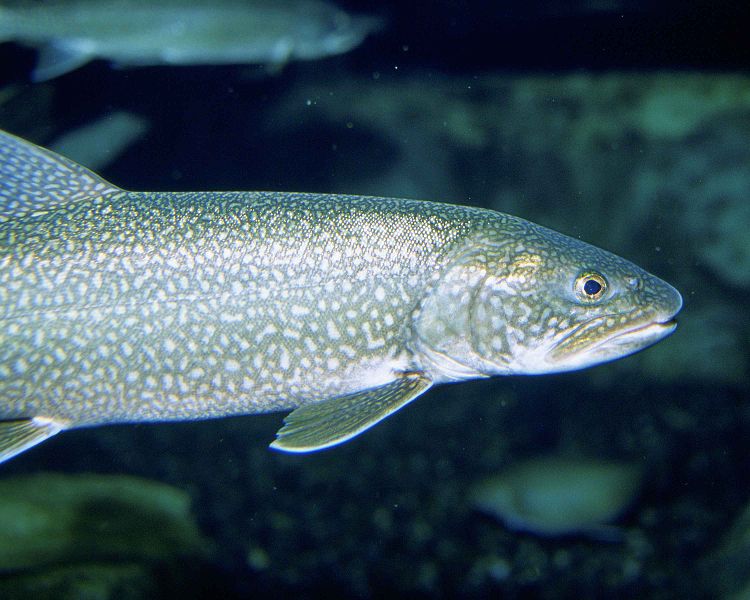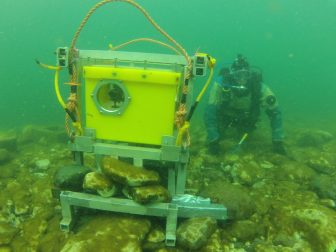
Lake trout are native to the Great Lakes. They are threatened by invasive species and habitat loss. Image: Eric Engbretson, U.S. Fish and Wildlife Service
By Carin Tunney
Lake trout make noise in bed, according to new research by Great Lakes scientists.
The species commonly growl, snap, quiver and thump while spawning, according to a study in the “Canadian Journal of Fisheries and Aquatic Sciences.”
The report may cause a smirk, but researchers say the findings are serious.
“Peeping on spawning lake trout with a camera and microphone could be the premise of an interesting comedy skit, but also makes for interesting science that could help improve how fish populations are monitored,” said Nick Johnson, an ecologist with the U.S. Geological Survey.
Scientists could potentially use the audio sounds to lure fish to spawning areas, Johnson said.
“If you walk down the street and hear a party going you might want to check it out,” he said. “There are historical reefs in the Great Lakes that are no longer being used for spawning . . . we may be able to play back the sounds of reproduction to lure in the trout and try to get them interested in spawning there.”
Johnson led a team that included researchers from Michigan State University, the University of Windsor and the University of Vermont, and that recorded spawning lake trout with cameras and hydrophones. Hydrophones are underwater microphones that detect the sounds of boats, waves and the quietest fish.
Researchers also used scuba gear to observe the fish more directly.
“(We) basically peep on those lake trout,” Johnson said.

USGS researcher Greg Kennedy installs monitoring equipment at a lake trout bed near Drummond Island, Michigan. Image: Nick Johnson, USGS
They tracked noises on spawning reefs and non-spawning areas in northern Lake Huron near Drummond Island and in Lake Champlain in Vermont.
The eavesdroppers heard snaps, growls and grunts in both locations along the spawning beds. Most sounds were made at night.
“It’s kind of cool to think about what is going on underwater as far as sound,” Johnson said. “We often look into the water and see things going on, so it is a new veil to lift when you put a hydrophone under the water … you can learn a lot about fish by listening and learning.”
Audio: Great Lakes Fishery Commission
Snaps were common before spawning, Johnson said. They may signal potential mates or tell other males to get away.
“It’s like a snap you would hear with your fingers and your teeth, and when we heard it in Drummond Island we believed it was related to fish being aggressive to each other or biting each other,” Johnson said.
He said growls occurred during spawning and are likely produced by the vibration of muscles during the act.
Audio: Great Lakes Fishery Commission
There were no visual indications of what created the thump sound, he said. But researchers think it could come from the gas bladder that helps a fish control its depth.
Audio: Great Lakes Fishery Commission
Researchers knew fish make noise. The exciting part of this study is using video and audio recordings, which hadn’t been done before with lake trout, Johnson said.
“The sounds fish produce in the Great Lakes have been generally overlooked or understudied to this point,” he said. “I think the underwater soundscape of the Great Lakes will likely be researched more in the future.”
Hydrophones can be left on reefs throughout the winter, making them more versatile than gillnets used to study lake trout, Johnson said. They could eventually help pinpoint lake trout spawning locations on deep, offshore reefs that are difficult to access.

Researchers used an underwater camera and hydrophone to observe spawning on Horseshoe Reef near Drummond Island. Image: Nick Johnson, USGS
Johnson said understanding sounds associated with reproduction is vital.
“It’s something that is hard to talk to your family about sometimes, what my job is,” Johnson said. “But we have an interest in lake trout restoration in the Great Lakes and one of the challenges is how lake trout locate other fish to reproduce.”
The research was supported by the Great Lakes Fishery Commission which oversees binational efforts addressing Great Lakes’ ecological concerns and threats.
Lake trout research remains a major emphasis, said Marc Gaden, communications director for the Great Lakes Fishery Commission. They haven’t recovered from drastic declines in the mid-1900s when sea lamprey invaded the lakes. The species also suffered from commercial overfishing.
Lake trout have rebounded in Lake Superior and Lake Huron, but maintaining populations is a challenge in Lake Michigan and Lake Ontario, he said.
The population in Lake Erie remains steady, but there’s concern because many lake trout don’t reach reproductive age, which is about 7 years old.
Current threats include invasive zebra mussels that cause habitat loss and alewives that “gobble up lake trout eggs like popcorn,” Gaden said. Scientists also believe trout become vitamin B1 deficient from eating alewives, which shortens their lifespan.
Monitoring the reproductive sounds could lead to better ways to restore lake trout, Gaden said. “The point is that understanding life history and habits and behavior is really a key to making good, creative, innovative decisions about management and restoration. And the fishery commission supports that kind of research.”
Funding came from the Great Lakes Restoration Initiative, a $300 million a year federal program that the Trump administration has proposed cutting.
A House appropriations committee recently voted to continue to fund the program as part of an Environmental Protection Agency spending bill.
It now advances to the full House.
Lake trout making sounds within a lab setting. Video: Great Lakes Fishery Commission